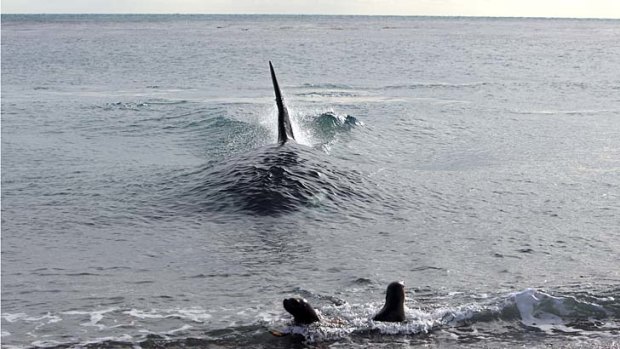
On approach ... an orca prepares to make a kill.Credit: Getty Images
Andrew Bain waits on a deserted beach for one of nature's most savage sights.
Argentina's Peninsula Valdes is renowned as one of the world's finest whale-watching destinations. For about six months of each year - from June to December - southern right whales crowd its protected bays, providing local tour boats with guaranteed sightings.
But outside the whale-watching season, an even grander ocean spectacle takes place around this pimple of barren land, midway between Buenos Aires and the southern tip of South America. As South American sea lions give birth along the peninsula's coast each February, pods of orcas arrive offshore, poised for one of nature's most dramatic hunting rituals. Riding waves onto the beach at Peninsula Valdes' northern tip, the orcas beach themselves to snatch at sea lion pups, dragging them out to sea, often in full view of gathered spectators.
By the time I arrive at Peninsula Valdes, I've travelled halfway around the world to witness a creature and a moment that will, quite possibly, not eventuate. Even at the best of times wildlife-watching is a gamble and this one is subject to all kinds of vagaries: tides, wave strength, orca appetites and orca moods. On the flight into nearby Trelew, I meet Maria, a tour guide on the peninsula. Each year, she says, she might see only three or four orca attacks.
On Peninsula Valdes, there are at least ample compensations. At a glance you'd almost think the stark, Nullarbor-like peninsula was a barren, lifeless place and yet it's one of South America's greatest wildlife treasures, with a host of exotic fauna. Grey foxes, armadillos, skunks, emu-like rheas and llama-like guanacos roam the scrub, while sea lions and elephant seals lounge on its shores.
In an utterly treeless landscape, the only things that rise above the knee-high scrub are the windmills, the guanacos and the tiny beach-resort town of Puerto Pyramides, where most of the wildlife struts about in thong bikinis. Five kilometres from town, beneath the cliffs of a headland, sea lions haul themselves out of the transparent sea and onto rock platforms. But to see the best of the peninsula and its wildlife, you must venture out to Valdes' tips.
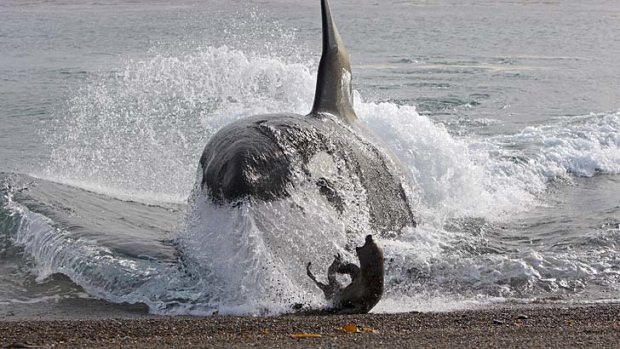
Animal kingdom... an orca beaches itself for a kill.Credit: Getty Images
Dirt roads circle the World Heritage-listed peninsula, and I head first to Punta Delgada. The hour-long drive is like a journey to the edge of the world. Past the white sheen of Salina Grande, a salt lake 40 metres below sea level, the scrub withers into grasslands. Fading signs for estancias blend into the colourless landscape, and a gaucho on horseback trots across the road, customary beret at its customary tilt on his head.
From atop the cliffs at Punta Delgada I peer down to a mass of unmoving elephant seals resembling washed-up tree trunks. Though they look like fat with fur, they are deceptively impressive creatures. They can dive as deep as 1500 metres and hold their breath for up to 90 minutes. Swimming thousands of kilometres, they've earned this rest on Peninsula Valdes.
Valdes is home to about 14,000 elephant seals, more than any other continental location in the world - only a few sub-Antarctic islands have larger populations. The greatest concentration of elephant seals on the peninsula is here at Punta Delgada.
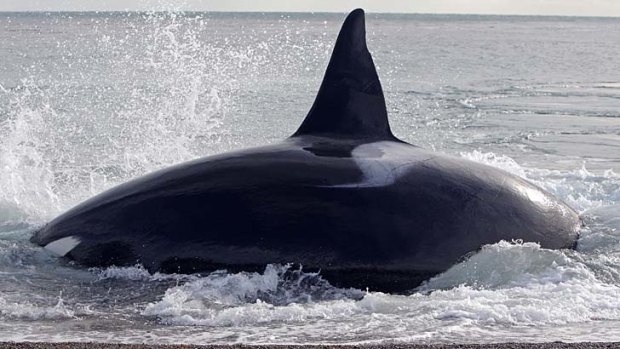
Risky strategy ... if the orca misjudges its timing, it can beach itself.Credit: Getty Images
I turn north from Punta Delgada and head along the coast towards the Caleta Valdes, a 30-kilometre gravel spit that creates a virtual lagoon along the east coast of the peninsula. Ships used to sail in to the Caleta to collect wool, but with the sea now said to be dumping about 1400 tonnes of gravel here every day, it's become impassable.
The main walking track here traverses the scrub for 1½ kilometres, coming to a viewpoint looking across the southern end of the spit. A few metres below the track, half a dozen Magellanic penguins stare back at me from the bushes. A pair steps out into the open and a mating ritual begins. The male dances circles around the female, bumping and chesting her as he turns, his wings wide in a look-at-me pose.
Uninterested, the female wanders away to the water, chased all the way by her beau. Minutes later, she's back, alone, having shrugged off her mate. Perhaps the Atlantic Ocean has been the cold shower he needed.
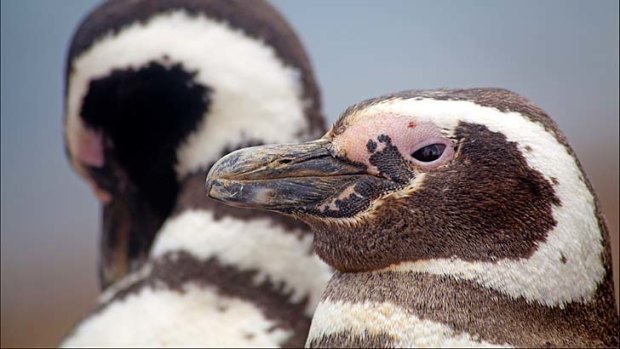
Magellanic penguins.Credit: Andrew Bain
Further along the Caleta, there's an even closer penguin encounter. Nesting no more than a metre or two from a roadside pull-out are several dozen Magellanic penguins - just a small part of the peninsula's 50,000-strong population - unperturbed by the people and cameras pointed at their striped faces.
Across the lagoon, the gravel spit is cut by several openings to the sea. They offer the first suggestion of potential orca activity. Known locally as "attack canals", the openings are occasionally used by the orca pods to access the lagoon. Here, in calm water, the orcas teach their young to hunt, beaching themselves on practice runs in this safer environment.
By now it's almost high tide, the prime time for orca attacks, so I continue north towards Punta Norte, the beach famed for this extraordinary hunting display.
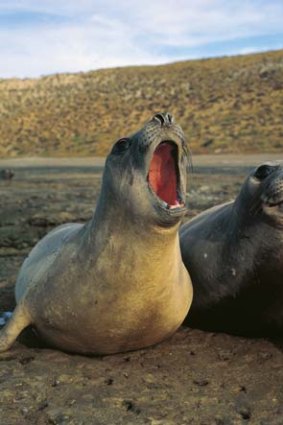
Valdes is home to about 14,000 elephant seals.Credit: Getty Images
I hear Punta Norte the moment I step out of my car - it might just as well be named Punta Noisy; mother sea lions bay for their pups, and the pups bleat in return, sounding every bit like lambs. Two armadillos - creatures that look like a cross between a small dog and a mediaeval shield - scuttle about the dunes.
Along the dunes is a walkway for visitors and an observation post for rangers. Below, the beach is filled with hundreds of sea lions, lined up along the water's edge. Knowing what I know, it looks like an orca smorgasbord.
With such anticipation, everything looks a little like an orca - the seabirds that float on the surface; a sea lion that rolls in the shallows, its flipper raised like a fin. For the remainder of the day I watch as sea lions surf ashore, and pups chase seagulls or run races along the beach. It's a playful scene, hardly a prequel to one of the ocean's most violent events, and yet the soundtrack to Jaws is stuck in my head.
For three hours I stand here, but no orcas show.
Next morning I'm back, arriving at Punta Norte just as its gates open at 8am. Overnight storms have all but washed out the peninsula's roads, and in slow-to-rise Argentina, I'm the only person here.
It's at this point that I'd like to be able to write that as I stand alone above the beach, I witness an orca thundering ashore to snatch a sea lion pup. Nothing arrives on the beach but waves. After hours of watching the sea lion pups at play, as frisky as puppies, I'm not certain I want one to be eaten any more.
Andrew Bain travelled courtesy of Peregrine Adventures.
FAST FACTS
Getting there
Aerolineas Argentinas has a fare to Trelew from Sydney for about $2020 low-season return, including tax. Fly to Buenos Aires (14hr 25min, where you need to stay a night both ways, own expense), then to Trelew (2hr); see aerolineas.com.au. Melbourne passengers pay about $100 more and fly Virgin Australia to and from Sydney to connect. Australians pay a $US100 reciprocity fee on arrival.
Touring there
Peregrine Adventures has a three-day Peninsula Valdes extension, beginning in Trelew, that can be added to any of its South American trips for $520. Nearby trips that make an easy connection include the 10-day Highlights of Argentina ($3095) and the 13-day Paine and Fitz Roy Adventure ($4995). Phone 1300 791 485, see peregrineadventures.com.au.
When to go
On Peninsula Valdes, most of the animals are seasonal visitors.
See orcas in February-April, August-November; southern right whales in June-December; Magellanic penguins in September-March; South American sea lions in August-June; elephant seals in September-April.
Sign up for the Traveller Deals newsletter
Get exclusive travel deals delivered straight to your inbox. Sign up now.